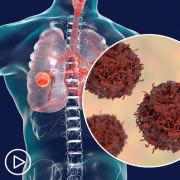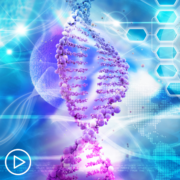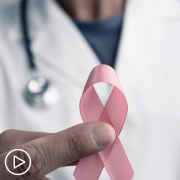How Are Targeted Therapy and Immunotherapy Used in Lung Cancer Care?
How Are Targeted Therapy and Immunotherapy Used in Lung Cancer Care? from Patient Empowerment Network on Vimeo.
Expert Dr. Heather Wakelee explains how targeted therapy and immunotherapy work to treat lung cancer and which patient type each therapy is most appropriate for.
Dr. Heather Wakelee is a thoracic medical oncologist and deputy director of the Stanford Cancer Institute where she also serves as the division chief of medical oncology. Learn more about Dr. Wakelee, here.
See More From INSIST! Lung Cancer
Related Programs:

What Are the Advantages of Newer Lung Cancer Treatment Approaches? |

|

Expert Perspective: Exciting Advances in Lung Cancer Treatment and Research |
Transcript:
Katherine:
Dr. Wakelee, you mentioned targeted therapies. How do they work?
Dr. Wakelee:
Targeted therapies are something we can use when we find a specific gene mutation in the tumor. So, I mentioned before that in order for a cancer cell to become cancer, something has to happen to the DNA in the cell.
And, there’s a change or a mutation in the DNA of the cell which leads it to be a cancer. And, a lot of the time, that mutation happens in a specific kind of gene that makes a type of protein called a tyrosine kinase. And for those of you who haven’t studied a lot of science, it’s a word you might not have heard before. But basically, these tyrosine kinases are proteins in the body that make a lot of changes to what’s going on in the rest of the cell. So, they’re sort of what we call regulators. And, one way of thinking about them is like on and off switches. So, normally, their job is to sit and if the right molecule comes around, that turns it on, and then it turns on other proteins in the cell. And if that molecule isn’t there, it’s turned off. So, it’s this on and off switch that does a lot of other aspects of what’s going on in the cell. But, sometimes, a mutation happens. It turns it on all the time. So, it’s like if you leave the light on.
It’s on all the time, that’s using a lot of energy, and that’s actually what’s driving the cell to act like a cancer. And so, we can now look for some of those mutations that turn some of these tyrosine kinases on all the time. But we’ve also developed drugs that we can use to turn them off. So, if we find this specific gene mutation that’s turning, say, the EGFR protein on all the time, if we find that, we can have the patient take a pill that then turns that off.
And that helps the cancer slow down, some of it die, some of the cancer cells die, but it doesn’t completely wipe it out. It helps the patient for a long time though by shrinking the cancer, helping them feel better because the symptoms are gone, keeping the cancer from growing. But, cancer cells are clever. They continue to divide, they can continue to make new mutations, and eventually, they figure out ways around that. So, when we talk about targeted therapy, it’s a setting where we find the cancer.
In the cancer, we find the gene mutation, it’s in one of these specific types of proteins, genes that make specific protein that turn something on that we can then turn off, and with those pill drugs, we can have a big impact for people.
Katherine:
And, what exactly is immunotherapy?
Dr. Wakelee:
Immunotherapies are treatments that were used to help keep the immune system more active.
So, the immune system is a very complex mechanism. There are cells that their whole job is to figure out and find things that are not us. So, they are looking for bacteria, they’re looking for cells that have a virus in them, and when they find it, they attack. And, that attack can be in the form of antibodies, it can be cells that actually go in and attack other cells directly, and we are all familiar a little bit with the immune system because we know that if we get a cold, our body, we can get a fever, that’s part of our immune response, and we get better. And then, some people know the bad side of the immune system if they have allergies or certain autoimmune diseases where the immune system gets a little bit too revved up and starts to recognize normal things as foreign.
So, in the setting of cancer, normally, the immune system is able to recognize a cancer cell, see that it’s different from the rest, and get rid of it. But, cancer cells are clever and they figure out ways to evade the immune system. And, one of the ways they do this is they put a protein called PD-L1. So, PD-L1 is a protein that a lot of our normal cells use to say, “Just a normal cell. Ignore me.”
And so, when an immune cell comes in and sees that, it gets turned off it goes away. So, what our immune therapies do is most of them are blocking that PD-L1 protein. And, when they do that, it’s sort of like taking away the stop sign. So, you’ve got a tumor using a stop sign to say, “Go away, immune cell,” you block it so the immune cells can’t see that stop sign, and so then it kills the cancer cell better. So, that’s how these drugs work, and that’s the immune therapy.
There are some other stop signs besides PD-1 and PD-L1, but that’s the most common. So, when we’re talking about immune therapy, it’s drugs that block that. So, they increase the ability for the immune cell to recognize cancers. The risk from them is that you can get the body to recognize normal tissue as a problem sometimes. So, that’s the toxicity that we watch for.










